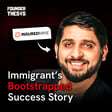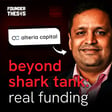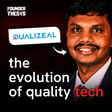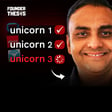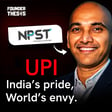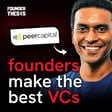Become a Creator today!Start creating today - Share your story with the world!
Start for free
00:00:00
00:00:01

A masterclass on indexes | Sanjay Arya @ Morningstar
Sanjay is an Indian-born American who built the index business of Morningstar. He talks about why indexes are a big business, how they have evolved over the years and what is on the horizon.
Read the text version of the episode here.
Read more about Morningstar:-
1.Morningstar Introduces Industry's First Global Unicorn Index Series
Transcript
Introduction and Index Basics
00:00:00
Speaker
My name is Sanjay Arya. I lead the innovation team at Morningstar, Morningstar Indexes.
00:00:17
Speaker
Even if you don't follow finance news, you would have surely heard of Sensex, which is basically an index representing the Indian equity market. An index is basically a basket of stocks, picked with some science behind it, which represents a view on something. For example, you can follow the small cap index to get a view on how small cap companies are performing in the stock market.
00:00:38
Speaker
This episode of the Foundathesis podcast is a masterclass in the business of indexes. Your host Akshay Dutt talks with Sanjay Arya, an Indian-born American who built the index business of Morningstar.
Building the Index Business at Morningstar
00:00:49
Speaker
Sanjay talks about why indexes are a big business, how they have evolved over the years and what is on the horizon. Stay tuned and subscribe to the Foundathesis podcast and any audio streaming app to understand the world of finance and business from a global perspective.
00:01:12
Speaker
You know, I sat down with our CEO at that time, Joe, who was the founder of the company. We had, I had a one page business plan. We had a 20 minute conversation and at the end of the conversation, he said, yeah, okay, let's do it. But be scrappy. And I actually did not, I was obviously excited and related about the whole thing, but I did not capture what scrappy means, which would be later on. I understood there's not a lot of money to be invested in the business, but see if you can make something out of it.
00:01:38
Speaker
The timing was good. I think it was a fun time to be in the industry where ETFs are beginning to grow and a lot happening. And ETF is an exchange traded fund. Yeah. So ETF is like an open end fund, which actually creates an intraday. So you can actually, it's generally started off as an index, taking an index basket and building an open end mutual fund around that. And so if somebody wanted to trade during the day, you could do that as well.
ETFs: Growth and Strategy at Morningstar
00:02:06
Speaker
So that's actually,
00:02:07
Speaker
So the difference between a mutual fund and an ETF is that in a mutual fund you pay money to the fund manager and if you want to withdraw money the fund manager gives it back to you but in an ETF that mutual fund can be sold to other people directly like you don't have to go through the fund manager.
00:02:26
Speaker
Right, so I guess it's listed on an exchange, so you're trading between, there's a transaction happening between two different entities. The other big difference in the U.S. obviously is that the tax benefit that you don't really, if you own an ETF, you don't really pay taxes on an annual basis, but in the U.S. you actually have to pay taxes on the mutual fund, on the realized, any unrealized gains as well.
00:02:50
Speaker
So it's much more a tax-efficient vehicle. So you control your own tax destiny. So when you sell, then you kind of have to pay. So there's added benefit to that as well. And all of the ETFs that were in the first generation, they were all index based. So they were low cost. And ETF can also continue to accept money directly from investors. It's not just people buying and selling on the exchange, but the fund also continues to take money in from investors.
00:03:15
Speaker
And the other thing is, since it's listed on an exchange, it's very transparent. So you know exactly all the underlying holdings, what's its holdings. So there are a few benefits that came along with that, and low cost being one of them. So I think that the whole notion of being a more investor-friendly structure, it appealed to a lot of people.
Challenges and Technological Evolution in Indexing
00:03:34
Speaker
And today, it's about $78 trillion in total assets of the management in ETF structure.
00:03:39
Speaker
So that was actually part of our initial motivation. We will build indexes that will be useful for Morningstar and its entire ecosystem and then be able to find ways to license it for other applications as well. And how does one go about building an index? Like how did you build your first index? And I'm sure it would have evolved that today the way of building an index would be very different.
00:04:02
Speaker
Yeah, you know, what we used to say was the barriers to entry at that point when we got in were very, very high. And today, the barriers to entry in the business are relatively low because the technology has evolved so much, the data is easily accessible. But the barriers to success in the business are still very high. It's dominated by a handful of very large providers. And then there's a long tail of providers who are actually, there's still, it's a big pie.
00:04:28
Speaker
They can have a small fraction of the pie, but the big pieces of the pie are still owned by some very large providers. But to your question again, I think what you really need is access to data that is coming from all the listed companies on an exchange. So you need to have, you know, capability to, you know, gather all the information, which you probably throw a Bloomberg subscription, you could get that.
00:04:51
Speaker
I guess there are sources you could get through which you can get that. If you want to maintain real-time calculation, I think that's a whole different ballgame because the indexes that have listed the ETS on it, you do need to be able to maintain that on a real-time basis. So you need to capture data as the trades are happening. You need to pick up those trades and the index, the company values.
00:05:14
Speaker
corporate actions, when the company's paying dividends, stock splits, and things of that nature, you need to have a good source to gather all of that as well. Yeah, and then be able to publish some of those. So those are the main, I would say, thresholds in order to gather that. So today, it doesn't seem it's outside the realm of possibility. But back in the day, it was that you really need to invest in technology and kind of be able to gather information from different exchanges around the world on the corporate actions that are happening. So those are main things. And then I guess if I try to find what are
00:05:43
Speaker
some of the unique gaps in the industry, once an index is done, or you have defined what the market makeup is.
Morningstar's Market Strategy: 3x3 Style Box
00:05:51
Speaker
It's basically the same thing that other people would come up later on. Is there value in kind of doing creating more of those indexes? I guess it becomes very hard. Once you define market, which is, we call it beta. Once the beta is defined, I guess there's not too many different ways you can actually enhance the value of that.
00:06:09
Speaker
There's no use making a broad index because everyone will use S&P 500. You would rather want to find a niche and make an index in that niche. What was Morningstar's journey in terms of what niches you made indexes for and how did you monetize them?
00:06:27
Speaker
Yeah, so I guess we always have the view that I think you want to focus on what you're really good at, or what you're known for. And I think Morningstar, when we started off, Morningstar is very well known for how we've taken mutual funds and we've created a two-dimensional 3x3, what we call the style box.
00:06:45
Speaker
So on the horizontal axis, we have value, core and growth. So you look at the other companies, what stage of growth they are in, are they value based or growth based. And then on the vertical axis, you know, large, mid and small. So it buckets all the companies in the universe along those two dimension into one of the nine boxes.
00:07:04
Speaker
And that's how we were looking at all the mutual funds, how the mutual fund managers are managing their portfolio, where their orientation was, and then using the same kind of lens to help people understand how the market is behaving.
Monetizing Indexes Post-Crisis
00:07:17
Speaker
It was helpful if you want to, you can have a big picture overall what the market is doing, but then
00:07:24
Speaker
Underneath the market, I guess it behaves very differently in large growth versus small, small value. So having been able to quite that nuanced insights into the market where the headwinds and tailwinds are, I think it was helpful. So we took that as a starting point, started off and it actually written it quite well because it's a lot of morning sales users who actually already understood that layer of the land. I think for them, this was a very helpful tool.
00:07:49
Speaker
Okay, so you created nine indexes that went for each of those boxes in the matrix. Yeah, so there were nine, one for each of them, I guess I would say that we combine the different permutation combinations. So there was a 16 total. So there's an overall market. And then there's a large cap, mid cap, small, and value, so overall, there were 19. But the nine components were the building blocks of the whole market.
00:08:16
Speaker
were mutually exclusive and exhaustive. If you combine them together, you get the whole market, but there was no overlap in any of the securities. What's the difference between a value stock and a growth stock? Value stock is something which actually is a
00:08:36
Speaker
companies that are not growing very fast, but they have good value. A lot of the banking energy sectors growth is generally kind of companies that are growing very fast, less focus on earnings and a lot of the technology type businesses you would find in that profit. How did you monetize once you created the index?
00:08:54
Speaker
Yeah, so I guess it was an easy journey. We built the products, and then it took us about two years to find a partner, which was a big milestone for us. And then they created ETS around that. There were nine ETS products that were launched and introduced.
Strategic Beta and Innovative Indexing
00:09:10
Speaker
And I think that started off our journey. But again, I think we certainly felt there was, in our industry,
00:09:19
Speaker
There's a huge inertia. So people do not change or move away from existing products or benchmarks unless they really have to. And there was no kind of compelling reason for them to do that. So we had the success and along the way we actually did some other interesting things. But the market was still pretty comprehensive. Again, I don't really need to see a lot of new products. I'm happy with the branded indexes that are existing out there. And then the global financial crisis happened.
00:09:46
Speaker
And then in the US, the market was on 38%. And I think people gave them a little bit of a pause that if I'm investing in an index, and the index, which people would say that this is inefficient, if you follow the efficient market, the market is actually the best gauge, and the market knows best. And market knows best. And if it's down 38%, there might be other ways for me to contemplate the investing. And that was actually, actually, for our business, actually, that was actually very beneficial because
00:10:15
Speaker
At the heart of it, our DNA is research. So we actually thrive in kind of understanding what are some of the factors that are driving management behavior or equity markets and so forth. And having access to a very large team of equity analysts, I guess we could lean on them to figure out what are some of the factors that are showing persistence in terms of that could add value
00:10:39
Speaker
to an investor's portfolio. I think that gave us an opportunity to maintain the indexing structure which we had mastered by that time. We knew exactly. One beautiful thing about being late to the market is I think you have to work harder to understand how you can add value and how you can bring value.
00:10:55
Speaker
In the U.S., there used to be, there still is actually a car company, Avis, RentalCar, and their model. We are number two, we work harder. And that was our thesis as well. I think there are index providers who've been there for 1,500 years before we got there. If you're going to make an impact of some sort, I think we're just going to have to understand and discover what we could do better. And we knew the indexing model quite well.
00:11:22
Speaker
But we wanted to explore how we can actually take that and use that in a different format. And that's where we brought in our equity research and post the global financial crisis, the whole notion of what is called strategic beta or smart beta. I think that started people starting getting comfortable with that. Again, I think the market is what it is. But perhaps there are better ways to bring in some active research, transparent,
00:11:46
Speaker
indexing structure that is much more investor friendly could be a better way to invest in index funds. So that was a tipping point for our business. We actually launched a product which was thinking of the best equity research that we had into an index structure in a very, very focused portfolio was like a 20 stock portfolio. And then later on, we expanded that to 40 stocks.
00:12:06
Speaker
But the holdings would be transparent, but the rates are very transparent, and people would license it to create an investment product, and we find partners along the way who actually did that and had tremendous success with that product. I want to break down some of the stuff that you spoke about. So you said after the financial meltdown of 2007, smart beta or strategic beta came into focus. What does this term mean?
00:12:36
Speaker
Yeah, I guess the traditional beta means that you actually, you invest with the market. So everything that's listed on the market, you're going to take that and proportionally, you include every single stock, whatever is part of the index in the same way, generally. So you're not making any bets there. You're basically saying that.
00:12:53
Speaker
you know, whatever the size of the market, the company is relative to the others. That's what your makeup of the index is going to be. It's that simple. Strategic beta is again, I think if you will, if you think of a spectrum on one side, you have the market and the other side, you have an active manager who's selecting stocks that have a high conviction about
00:13:12
Speaker
It's somewhere in the middle where you try to bring the two pieces together that you still preserve the indexing model where it's a rule based transparent, you periodically rebalance the portfolios, but you are not betting on the same, all the companies and all the size and everything.
00:13:29
Speaker
you have a way to identify that there might be a factor that you have conviction about and you are using that to introduce a bias or selection criteria that help you or whatever your objective might be. If you're looking to generate alpha that would be the one if you're looking for more income or mitigate risk. I guess you could actually do with whatever proven research you have access to. Alpha means what an active investor is able to generate over and above the market that is alpha. That's right.
Smart Beta Products and Private Market Indexes
00:13:59
Speaker
That's right. Yeah, so that as a as an active investor, that's what you aspire to do. You're trying to beat the market. And as an active investment manager, I guess that's what you people interest you to do with their money that
00:14:12
Speaker
you should be able to beat the market. If not, then why bother? I can actually go with an index fund and kind of save some money there. So having, I guess, say within Morningstar, I guess we were very privileged and we still are, we have like an ecosystem of research pods, equity research and ESC research and asset allocation research where we can actually understand what the models asset allocation can add value.
00:14:33
Speaker
So having unfettered access to some of that research allows us to experiment and kind of look at things a bit differently. And we do have the indexing model, which we know quite well, but then trying to meld some of the other research. It is just bringing a different style of indexing that actually, you know, I think for the future, this is how it's going to be as we think about the industry is evolving.
00:14:56
Speaker
I'm still not fully clear on what is this new product that you made, which was based on research. You lost a new type of index, which was based on research. What is that? How is it different from the other indexes around? So we have a team of 125 analysts, which was actually smaller at that time. And they do research and they have recommendation on like a buy sell hold and a target price. Right.
00:15:24
Speaker
So they have, you know, they first look at the business fundamentals. Is the company, does it have any moat in the business? So they have an economic moat rating, wide moat, narrow moat, no moat. It's a term from Warren Buffett. You want to go for businesses that have a wide moat and they have something unique advantage that are difficult to replicate.
00:15:44
Speaker
which means they will have more pricing power and high margins and so forth. And then they also look at the, they do their own discount cash flow and come up with evaluation models. If the company is trading below their expectation or above or whatever. So taking a combination of companies that have a wide moat, which are businesses that have more entrenched pricing power and which are trading at a discount. So we selected, so it's a, there's a lot of active research that goes into determining those criteria.
00:16:13
Speaker
But beyond that, I guess we have rules which have been established that once a quarter, we look at the 20 cheapest white mode businesses. So that'll be the basket we actually create the index of. So I would say it's a marriage between kind of active and passive to create something that'll actually
00:16:30
Speaker
In this case, the index is not giving you beta, it's giving you alpha. And it's actually done quite well. It's not every year, it's actually hitting it out of the park. But for the most part, when you look at the long term, it's actually when you look at the peer group in the large core category, it's actually been in the top decile for over the last 10 years or so.
00:16:51
Speaker
So again, I think it's just necessity is the mother of invention. We had something when the barriers were very high and I think what we went back to, what we were really good at is our research and we tried to bring that into the indexing practice. Interesting. So this is in a way like
00:17:11
Speaker
and unbundling of the actively managed mutual fund what it used to be. So an actively managed mutual fund would probably be doing something like this where they would say, okay, let's look at companies which are value picks and have a good board and they would manage that money for you and charge at 2% or 1% or whatever.
00:17:30
Speaker
So now this has got unbundled where Morningstar is doing this research and creating an index, which is equivalent to what a mutual fund might have been doing. And now an index mutual fund can be built on top of that with a very low fees, which overall benefits the investors. Yeah. So it's a combination of, if you think about, I guess it's a, like I said, it's a marriage between good, active and passive. You bring some of those, the attributes of an index and you know,
00:18:00
Speaker
The benefits of active and the cost of passive basically, like for an investor. Yeah. So that's study beta, what we call it morning. So people call it the smart beta, enhanced beta, whatever the many different terms in the industry. But it's, let's say if you were to do a VAN diagram, it's like the overlapping part in the middle where you have passive and active on either side. But this is where you kind of meet in the middle.
00:18:23
Speaker
Yeah, very interesting. Very innovative in terms of how it's cut down cost for actively managed. You're getting an actively managed portfolio at one depth of cost, basically. Super interesting. So you've now also launched an index for the private market. Tell me about that. What is the use case for an index on private market and what made you want to launch that?
00:18:48
Speaker
Yeah, so I think, as I mentioned earlier, I think we see there's been a tremendous shift from public to private. And I think this segment of the market, which is really at explosive growth, is a lead stage private venture, venture-backed businesses. You know, the term unicorn, which is a private venture-backed company, is with a billion dollar in market valuation. It was coined in 2014, and it was named after a mythical creature, the unicorn, which means it's very rare.
00:19:16
Speaker
And at that time, there's about less than 40 unicorns globally. And I think it was... Yeah, India probably had just one. I think Inmobi was probably the only unicorn at that time. Yeah.
00:19:29
Speaker
Yeah, today there's about close to about 1,300 unicorns and some of these are deca colons, some of them like bite down, so it's like 300 billion stripe per 100 billion. So these are not rare anymore and these are not small anymore. So there's a whole segment of the market that's actually PIPO that is actually huge and this market is going.
00:19:49
Speaker
And you hear anecdotally people saying that this is a market which is actually doing really well. But there's no gauge, there's no market sentiment, there's no understanding what the market looks like. So having the pitch book, the level of data that they have and research they have, we are very fortunate to be able to take some of that. Even though it's very unstructured data, unlike public markets where each company has a ticker and a Q-SIP and it's very easy to manage and move things around.
00:20:13
Speaker
We had to jump a lot of hoops in order to normalize the state and create a more structured way so we can build some of the index back histories and normalize some of this. But we were very excited. I think now we can shine the light on what the market looks like in this space. This is between companies going before they go public and the late stage.
00:20:33
Speaker
And this is where, in our view, convergence of public and private markets is beginning to happen. So you see a lot of mutual fund managers, what they call crossover managers, they're beginning to own late-stage private companies in the mutual fund portfolios. And you have the traditional VCs and the general pension plans and the like who are actually investing in that. And this market is going to become much more
00:20:56
Speaker
visible and transparent and our goal is to whatever we can do to shine the light and kind of help people understand what are the risks when people say i think there's more than meets the eye there you saw fdx which was another company that just went bankrupt from 32 billion to zero those kind of things and when you aggregate the whole market i think it'll give you a full picture in terms of owner day leaders you know what are the markets behaving what are the long-term risk and return features of this market
00:21:22
Speaker
If you want to look at through the lengths of different industry verticals, what are the fintech or what are some of the SaaS businesses doing, you'd be able to slice and dice some of that as well. It's a big new video. And again, I think we think this first step is create a market sentiment. And then as the market infrastructure improves, I think there will probably be ways you can invest in this segment of the market as well. We are not there, but there is any. And if there are managers who are actually investing purely in this segment,
00:21:50
Speaker
This would be a reasonable benchmark for them as well. Interesting. What is your unicorn index? How many companies does it consist of? How did you build it? Help me understand that.
00:22:08
Speaker
Yeah, so I think though today there's about like I said, 1300 companies that are part of the unicorn and we have a broad global index, which actually includes all of those. I would say that's akin to like a beta product in this space. And then we have, then we have 11 or 10 other regional indexes. So there's a US, UK, China, and India. And you include all the whole universe of US unicorns is included and same for India and so on.
00:22:34
Speaker
Yeah, so there's a broad product for US which has about 650 or so, which is what should we have the unicorn out there. And then we have a US 100, which is a scaled on version of the parent index. It's this is indexing science here. But with 100 securities, we can actually replicate almost 99.9. The correlation is very high.
00:22:54
Speaker
so you don't really need to have all the every single company that being part of that. Same thing we have the UK index and then China and India. In India we have India 25. The total number for unicorns in India is somewhere between 70 and 100. The number is disputable but whatever. The 25 actually will give you a very healthy kind of mix of what the market looks like and you know what it tracks the broad index quite well.
The Unicorn Index: Development and Impact
00:23:18
Speaker
So again, I think the other thing we've done is we built a pricing model that goes beyond with unicorns or any private company for that matter. A value is ascribed only when a new deal happens. And it's like real estate. Typically when that transaction happens, typically it's like once every 18 months or so on average. But what happens in those 18 months, especially in the last 18 months, a lot can change. And our goal is to be able to
00:23:43
Speaker
Present what is the more indicative value of the market in that time period as well. So we've looked at other places where there's some price discovery on the private market side, looking at companies that are similar to the business we are looking at. So Pitchwick has analysts who actually can help us.
00:23:59
Speaker
look at what are some of the cohorts, similar companies, and if there's a funding round that is happening in those, that actually provides you an indication of where the market's heading. Likewise, on the public market side as well, there are industries within which the index of the company sits. So we can use that as an indication of how the price
00:24:19
Speaker
is likely to be plenty of research out there that shows there's a 9 to 12 month lag between public markets and private markets. So we are able to bundle all of those three factors together and on a daily basis we are able to get a single value for each company and provide a market view which is more realistic view as opposed to looking at the last few values.
00:24:40
Speaker
Okay, so for example Amazon is a publicly traded company and price movement of Amazon would affect Flipkart's valuation in India, which you would factor in to create a real-time daily update of Flipkart's valuation. In addition to let's say other transactions happening in the e-commerce space, so all of those would factor into a daily revision of Flipkart's estimated value.
00:25:05
Speaker
That's right. Swiggy is a big Indian food delivery company and you have comparables like DoDash and others who've gone public. And Zobato is just listed in India Health, yeah. So you can actually look at their fluctuations in their market value because within the industry cohort there's a lot of systematic risks that you can actually, which are very similar to the businesses.
00:25:26
Speaker
Similarly, Paytm's price would influence all fintech companies pricing evaluation in the index. Okay, so right now you are in, like you told me, the first time you built an index, it took you two years to monetize. So right now you are in that two year phase basically of this index, because
00:25:43
Speaker
Monetization right now is tough because there is no exchange for buying and selling stocks of startups, which are not listed, but you feel that eventually some liquidity would come in here. Like you would be able to buy and sell stocks of unlisted startups.
00:26:03
Speaker
Yeah, you would be surprised. I think where there's a will, there's a way. I think we actually, even in the short period, we've since we've announced the introduction of our indexes, we've actually had people from different parts of the world reach out and said that we've been thinking about this or we've actually built our own index, which is on a spreadsheet, but gives us something that we can actually hang our hat on and use it. And they've got some ideas in terms of synthetically or other ways they would actually start looking at it. And
00:26:29
Speaker
You know, the arc of innovation will certainly solve some of these problems today. It's not easy to fully replicate it, and I don't think we will ever get there. But the main thing is exposure. And there's a lot of wealthy investors who are looking to gain exposure to this segment of the market. There are funds out there, but I think when you look at the fee structure, it's very traditional institutional 2020, which are very high.
00:26:52
Speaker
So I'm sure there's folks who will actually figure out like how to do it in a more cost efficient manner. And you know, our goal is we've got the infrastructure and we can create more bespoke products. If somebody has a need that we don't have to have a hundred stock portfolio, we can actually make it smaller based on what is more tradable or what is more accessible to from the market. So again, I think it's going to be a little bit collaborative in terms of working with the prospective asset manager in terms of what their needs are and how we kind of solve these problems.
00:27:23
Speaker
Interesting. So there are two use cases for this currently. One would be like say, Sequoia would use this too as a benchmark that are they doing better than the unicorn index because Sequoia is essentially private equity investor. And the second is to build synthetic products. Now help our listeners understand what's a synthetic product which could be built on top of the unicorn index.
Future of Indexing: Personalization and Innovation
00:27:49
Speaker
Yeah, so I think we've got a history in terms of what the risk return pattern of this index looks like. Plenty of these global banks who actually know how to synthetically replicate, when you give them a reduced return profile, they can use derivatives to create, to replicate that. And with the swap product, I guess there could be somebody on the long side and somebody in the short side, then long side people who are looking to invest and gain exposure for the long term.
00:28:15
Speaker
And on the short side, somebody who already has exposure and they're trying to mitigate the risk. So they would sit in the middle and be able to use some kind of a derivative instrument to predict what the pattern of terms going forward would be. Okay. What is your view on the future of the indexing industry?
00:28:33
Speaker
Yeah, so obviously I think the industry has grown so much and today, I think I might have mentioned this earlier, the beta has become commoditized. So there's no, I guess it's a race to the bottom in terms of how you access it. And we've already seen that. And again, gradually, I think all of that we see with the big providers in the US, the BlackRock, iShares, and Vanguard, and State Street, it's basically
00:28:55
Speaker
It's an access point. It's not something unique that anybody can offer. So the cost is obviously going to be a big determinant in terms of how this is delivered. We see, I guess, the future innovations are going to be in some areas like ESC. Again, I think how people are trying to align their portfolios to their value systems and belief systems. And they believe in climate is going to have an impact on how to express their convictions.
00:29:18
Speaker
in that way. And then the third thing I would say is I think the whole notion of personalization, direct indexing is another area which has already caught on. So direct indexing is you take a starting point as an indexing basket and then you can actually eliminate some stocks based on, let's say if you work for a technology company or in that sector and you don't want any more exposure, you can actually underweight that segment. It just gives you a lot more ability to personalize it.
00:29:46
Speaker
And with the technology today, it's almost all the major asset managers and wealth managers are now beginning to offer you that personalization. So you don't have to buy an index one, but you can have an index which is tailored to your personal needs. And it could be you can also implement your personal ESE. So you don't have to buy an ESE fund, which might be very generic in terms of one size fits all.
00:30:10
Speaker
But if you care about tobacco not being part of it or guns not being part of it, you can actually eliminate some of that exposure as well. And that brings us to the end of this conversation. I want to ask you for a favor now. Did you like listening to this show? I'd love to hear your feedback about it. Do you have your own startup ideas? I'd love to hear them.
00:30:29
Speaker
Do you have questions for any of the guests that you heard about in this show? I'd love to get your questions and pass them on to the guests. Write to me at ad at the podium dot in. That's ad at t h e p o d i u m dot in.
